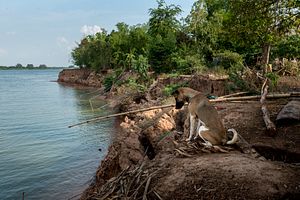Luc Forsyth and Gareth Bright have set out on a journey to follow the Mekong river from sea to source. The Diplomat will be sharing some of the stories they’ve found along the way. For more about the project, check out the whole series here.
In this installment of A River’s Tail, we explore how two communities are being affected by the ecologically devastating practice of sand dredging, and how a building site in Singapore can forever alter the lives of those who live along the Mekong.
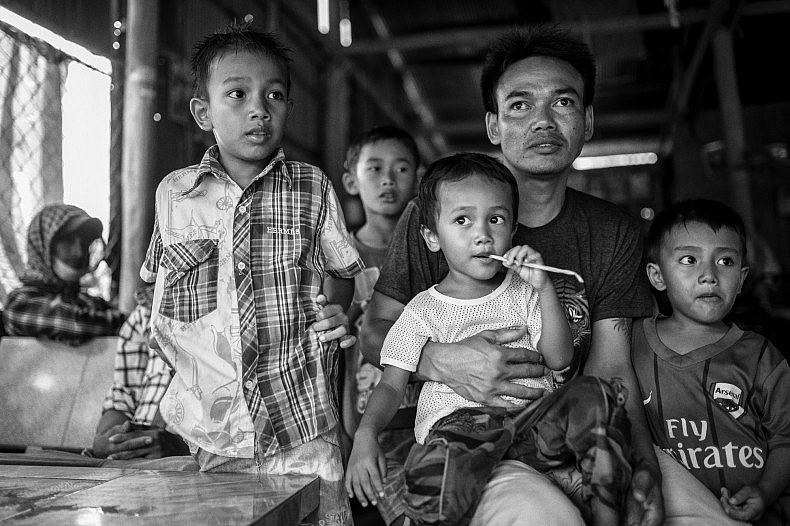
A local family sits in a cafe while explaining their plight to survive in the face of heavy erosion in the village of Khpob Ateav. The Mekong’s banks are eroding at the rate of roughly 4-5 meters per year in the area, and the brothers will have to dismantle their home and move within months or else it will collapse into the water below. Photo by Gareth Bright.
From where we sat the truth of Bunthea’s statement was apparent. Instead of a naturally sloping river bank, there was a hard, uneven precipice that dropped abruptly to the water five meters below. As we watched two of his children throw stones into the river, it looked as though an earthquake had ripped the land away by force and left a jagged scar in its place. Whenever they got too near the edge, he shouted at them to move back, apparently worried that the sandy lip could give way at any time.
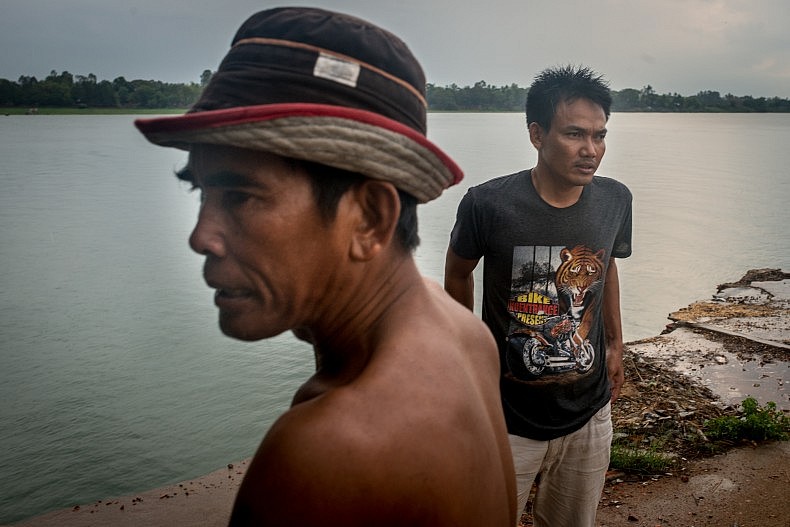
Yea Buthea, 50, (foreground) and his brother Yen Bunsong, 35, (background), stand on the edge of their family property. The Mekong’s banks are eroding at the rate of roughly 4-5 meters per year in the area, and the brothers will have to dismantle their home and move within months or else it will collapse into the water below. Photo by Luc Forsyth.
Looking around, it was easy to see why he was worried. To the left of his home was an empty lot where his neighbor’s house had been; a lonely staircase was the only remaining evidence that it had ever existed. Where it should have stood there was no land, only empty space over the water. “Our neighbor took his house down and moved inland a few years ago,” Bunthea explained. “We are also planning to move in a few months because our house will also collapse into the river soon.”
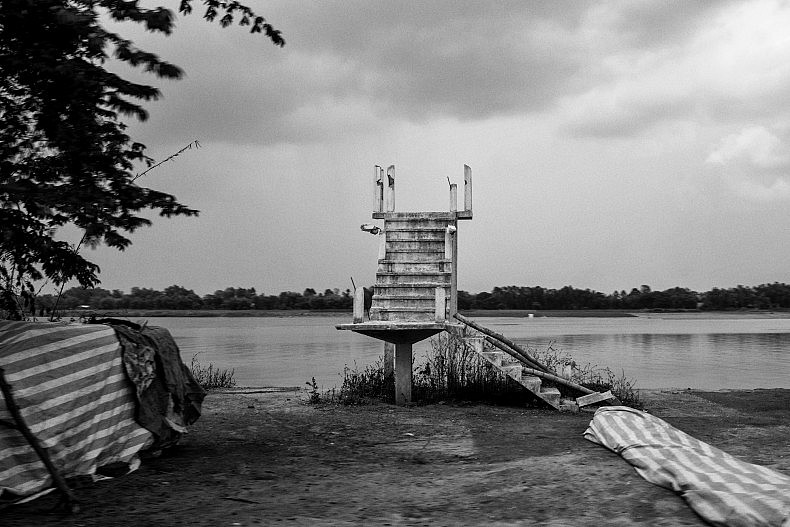
A staircase on the edge of the Mekong. The stairs are the only remains of a house whose owners were forced to relocate as river erosion washed away their land. Photo by Gareth Bright.
Bunthea’s brother Bunsong took us on a tour of the family property, showing us the narrow patch of sandy earth that lay between their home and the Mekong’s currents. Bunsong said the banks were eroding at the rate of 4-5 meters per year, and had been doing so for the last decade. If the trend continued, as it almost certainly would, the family had very little time left.
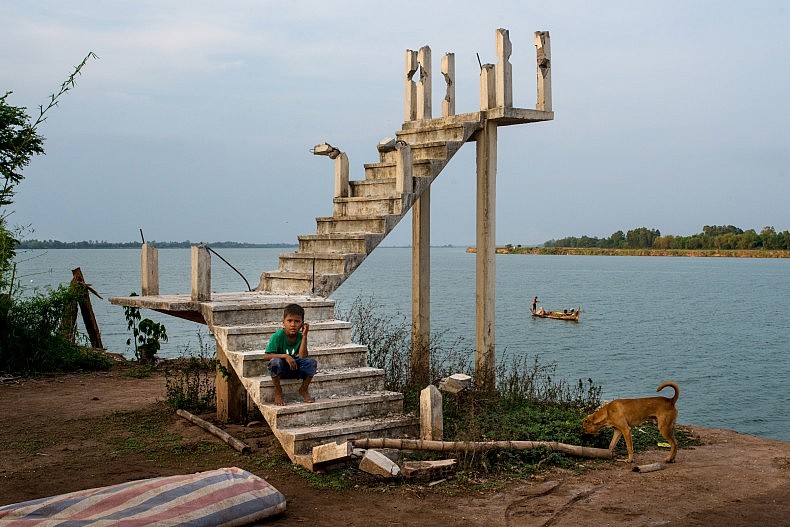
A boys sits on a staircase on the edge of the Mekong. The stairs are the only remains of a house whose owners were forced to relocate as river erosion washed away their land. Photo by Luc Forsyth.
An Insatiable Skyline
River banks are shifting entities, not static structures. They collapse and expand according to water flow, rain patterns, and sediment replenishment. But what we were seeing in Khpob Ateav was too fast and extreme to be part of any natural cycle. Only human activity had the power to affect the environment in such a drastic way, and from our preliminary research, we knew what was responsible.
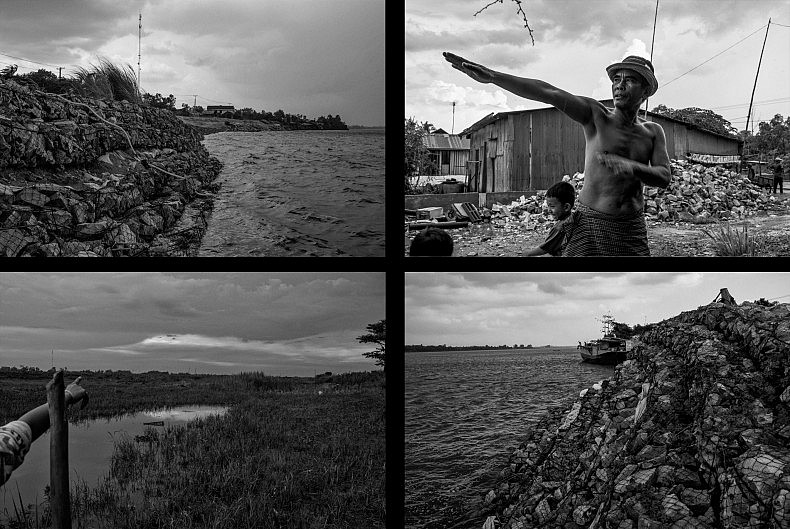
Photos by Gareth Bright
Sand is a commodity that is generally taken for granted. It lacks the glamour of substances such as gold or diamonds, and is worth far less by volume than coal or oil. It is a substance that most of us think of as abundant and virtually worthless, and yet it is neither. Wherever concrete is required — which is in nearly every building project everywhere in the world — sand is needed in great quantities. In Singapore alone, which has expanded in size by more than 20 percent since the 1960s, over 14 million tonnes of sand have been used for land reclamation and construction — much of it coming from Cambodia.
That sand has to come from somewhere, and in Cambodia that often means dredging it from the Mekong.
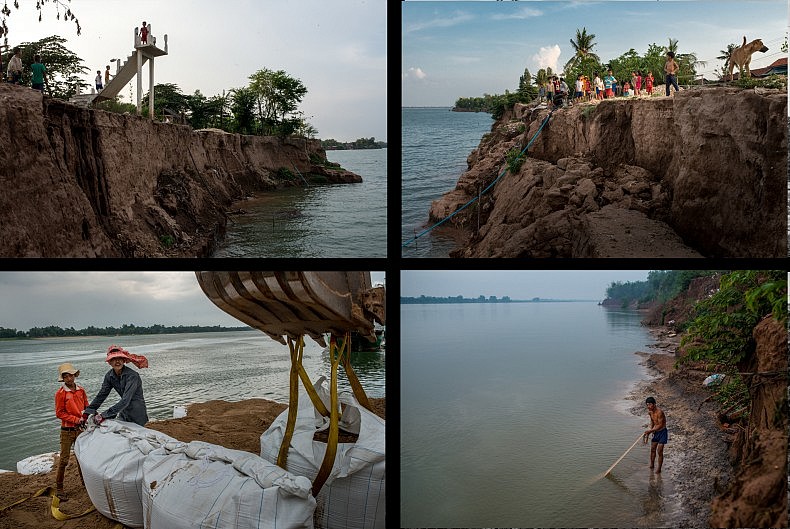
Photos by Luc Forsyth.
The international natural resource and human rights watchdog Global Witness has released a far more comprehensive report on the impacts of sand dredging than we could possibly hope to match, so we will keep it simple: sand dredging changes the course, flow, and sediment distribution levels of rivers. For the residents of Khpob Ateav, that means the their land is being washed away much faster than it is replaced.
Talking with Bunthea and Bunsong, it was clear that they didn’t fully understand the cause of their dilemma. They knew that something was wrong, but not why. When a family is struggling to keep above the poverty line, how can you explain that their backyard is vanishing so that a new condo can go up in a country 1,300 km away?
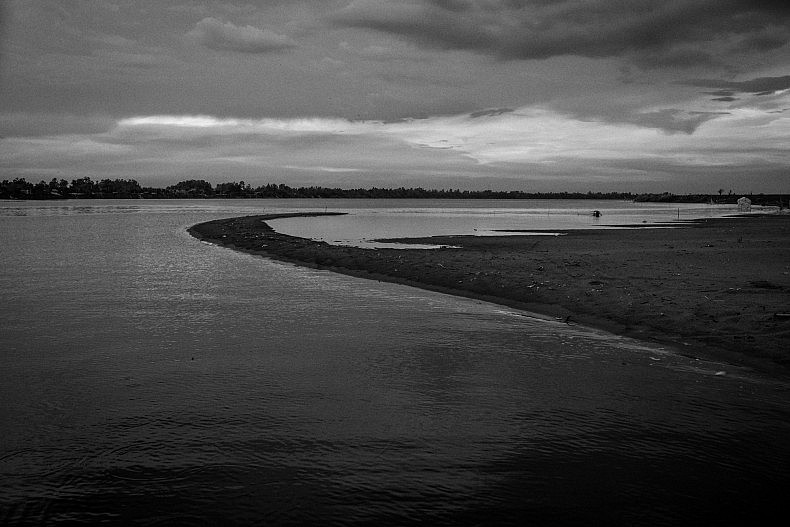
Since the erosion of the banks of the Mekong started taking place in the Village of Khpob Ateav the island of Peam Reang, Cambodia has seen massive extensions to their island in the form of large sandy beaches. Photo by Gareth Bright.
Winners and Losers
To board the ferry from Khpob Anteav to the nearby island of Peam Reang we slid down a slick slope of red-brown mud with a distinct lack of grace that delighted the locals who had gathered to watch. In a cruel twist of irony, Bunthea told us that as his land was washed away, portions of it drifted across the river and settled around the periphery of Peam Reang, creating a boon for island residents in the form of new farming land where before there was only water.
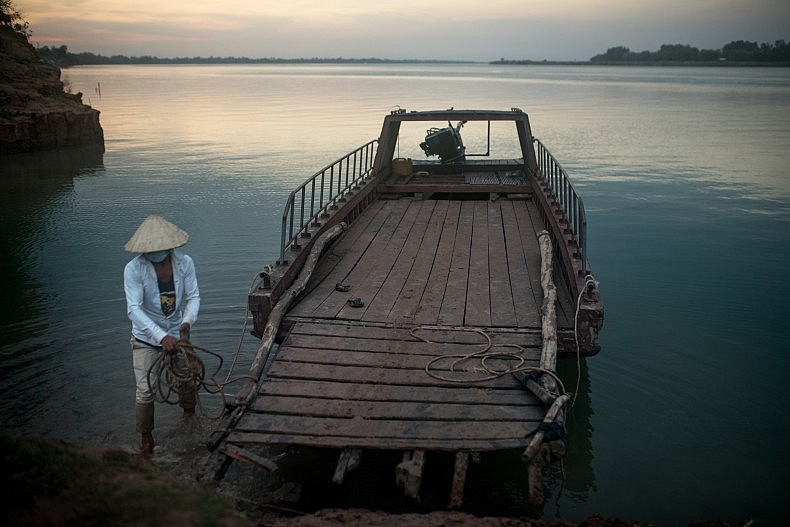
The driver of a ferry that shuttles locals between the village of Khpob Ateav and the island of Peam Reang docks his vessel as darkness approaches. Photo by Luc Forsyth.
As the ferry drew closer to the diamond-shaped island we were able to take in the scope of the land transfer. A vast expanse of fine sand extended from the coastline in a crescent that was at least 2 km wide at its base. It might have seemed like a natural beach had it not contrasted so glaringly with the island’s existing jungle topography.
“I’ve been farming here my whole life,” said Chheng Tre, a 59-year-old farmer we met while exploring the sand flat, “and the land never changed. But in the last 3 years an extra 60 meters have been added.”
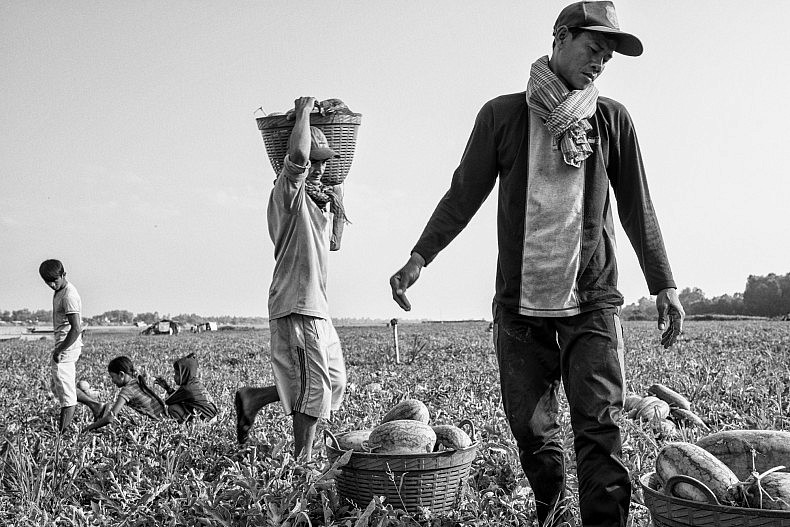
Workers harvest watermelons on the island of Peam Reang. As erosion strips land from the banks of the Mekong, some of the sand washes up on the coast of the island, creating new farmland ideal for watermelon growing. Photo by Gareth Bright.
Not without empathy, Tre admitted that while the increase in farmable land has been a blessing to Peam Reang residents, it has come at the expense of those living on the mainland. For an island on which every square meter of arable land had been claimed for generations, the sudden availability of open ground must have seemed like a miraculous gift — one that they were rapidly moving to exploit. Vibrant green watermelon patches blanketed the edges of the newly emerged ground, and young men were busy plowing the remaining area, eager to make sure they didn’t miss out on their share of the bonanza.
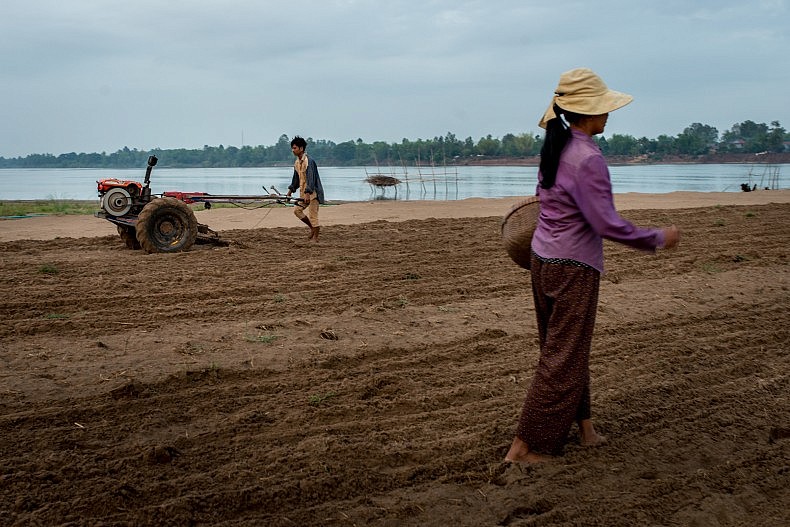
A mother and son work to cultivate a piece of sandy land on the coast of the island of Peam Reang. As erosion strips land from the banks of the Mekong, some of the sand washes up on the coast of the island, creating new farmland ideal for watermelon growing. Photos by Luc Forsyth.
Though the people on Peam Reang hadn’t meant to steal the land from the families of Khpob Anteav, the situation still seemed like an injustice of the highest order. Powerful Cambodian oligarchs were reaping immense profits from selling the Mekong’s sand to foreign countries with little, if any, concern for the people who were being displaced. While it needs to be noted that a construction crew was working to put up makeshift erosion barricades, the extent and rate of the disappearance of the river banks made it doubtful that the repair efforts would ever keep pace with the destruction.
As we made our way back towards Cambodia’s capital of Phnom Penh, what we had seen reinforced a fact we already knew to be true after our time in Vietnam: when people interfere with the river, those who live downstream are at risk. It is impossible to know what will happen to the people of Khpob Ateav, but if more consideration is not given to how the Mekong is treated, they are in peril of being washed away.
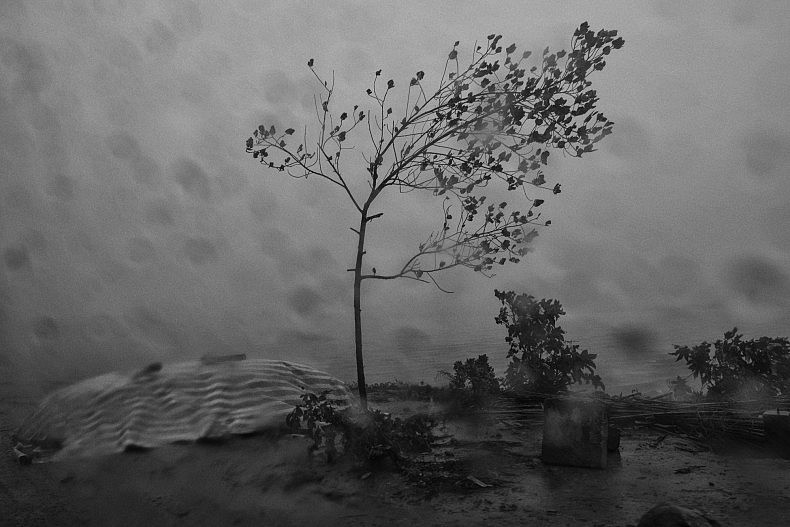
A small tree stands strong against the monsoon rains in the village of village of Khpob Ateav on the banks of the Mekong in Cambodia. Photo by Gareth Bright.
This piece originally appeared at A River’s Tail.













